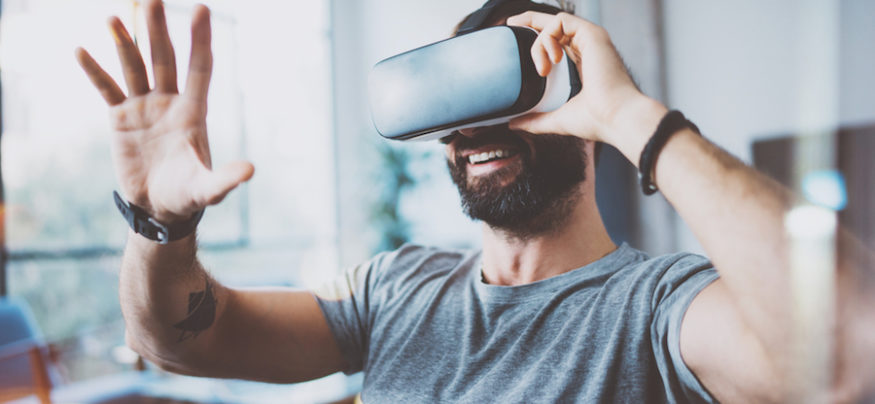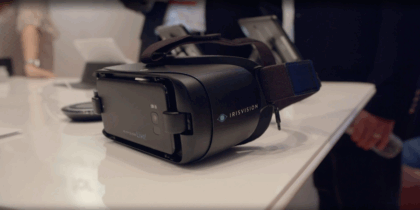Creating a distribution platform for VR training content can be both time-consuming and costly considering the development involved and the tools needed to support custom interactions. To help organizations make the most out of their content, Samsung offers a comprehensive VR distribution platform via the Samsung VR Videos app.
Although on the surface it may seem like a VR entertainment platform, a look under the hood reveals that Samsung VR Videos is much more than that. The platform can work with just about any format of VR content and several types of spatial audio, queue up synchronized content on multiple devices at the same time, livestream and even incorporate interactive hotspots directly in the 360 video.
Here’s a look at how organizations can leverage the Samsung VR Creator Portal to build 360 video training modules.
Introduction to Samsung VR
The Samsung VR Video platform is available on the Samsung Gear VR, Oculus Go, Apple iTunes and as a standalone Android app for viewing 360 content outside of the headset.
The player is compatible with an extensive range of playback formats. The platform supports over 24 different video types with various aspect ratios and projections, including the most commonly used options like monoscopic 360, stereoscopic 360, and stereoscopic 180. Nearly any type of VR video format is supported, and it will play them sideloaded to the device, from your channel uploaded through Samsung VR Videos, or even livestreamed through media servers.
It also supports several different audio types, including mono, stereo, ambisonic, 5.1 spatial, quadraphonic, binaural and Mach 1 spatial. Implementing spatial audio can be a clever way to direct attention by carefully placing audio cues in the VR environment. Quadraphonic audio can also be used as a unique storytelling tool. Unlike spatial, it will fade between tracks depending on where the viewer is looking. This allows the content creator to conceal or reveal details within the experience based on where attention is focused — opening up intriguing possibilities for interactive, dynamic experiences.
Leveraging Samsung VR features
One of the biggest challenges when it comes to teaching and training with VR content is not knowing what the viewer is seeing in the headset, making actions and outcomes difficult to monitor.
Samsung solves this problem by offering Presentation Mode, a feature that allows the actions from the primary Gear VR headset to be mirrored on other Samsung devices running the Samsung VR app. When one device is set as the presenter, it will mirror all actions to any devices in receiver mode on the same network. This means you can monitor what learners are seeing, or guide them through several instructional videos in real time while you watch together.
The Ultimate Guide to 360 Video Production
Everything you need to start creating 360 video, from pre-production to post and distribution. Download Now
You can also start 360 video content for a multitude of headset wearers simultaneously with synchronization enabled. After ensuring all devices are on the same network, simply sideload the same video to each device along with a configuration file to set them up for sync. A training facilitator can control the start of the 360 video experience with a separate device running Samsung VR mobile. You can learn more about Presenter Mode and synchronization in the Samsung VR FAQ.
If you simply want to start your training content for each user without extra menus and UI to dig through, the app also offers a “retail mode” that can be set in configuration. Videos you have sideloaded in retail mode will automatically start as soon as the user launches the app. If more than one video is loaded, it will automatically loop through a playlist. You can also define a timer for how long the headset takes to reset the video experience after the viewer takes it off, ensuring that users can start where they left off if they need a quick break.
With a livestreaming-capable 360 camera like the Samsung 360 Round, organizations can even host live training events in stereoscopic 3D at 4K per eye, giving any number of trainees a truly immersive 1-on-1 training experience with a trainer anywhere in the world. By deploying VR video for training, you can eliminate the need to pay travel costs and easily provide training to a much larger audience.
You can get started by creating a free account with the Samsung VR Creator Portal. With an account, you’ll be able to upload 360 video content directly to the portal, for public or private use. You can also customize your channel’s room with its own unique background panorama, add your branding, stabilize your videos, gain access to insightful analytics and much more.
Creating interactive, branching stories
Beyond linear 360 videos, the next step is to give your learners the ability to choose. When they’re faced with tough decisions while watching immersive 360 video, these decisions challenge them to act and apply what they’ve learned within a realistic environment. Though Samsung VR’s interactive features within the Creator Portal are currently in beta phases, organizations can request early access by way of the support page so they’re fully prepared when the functionality goes live.
Here’s how it works. First, you need to break your content down into individual clips, then upload those clips separately under the Interactive tab. You’ll then have access to all of those clips when building your branching module. You can choose whether each clip will loop, end the experience, or move on to another clip.
While an experience is being played in the headset, you can either link clips using a hotspot, or create vignettes that bring the viewer back to the parent scene after they’re done playing. Hotspots can be positioned anywhere in the scene within the interactive 360 editor, and resized as desired. You can also choose transition clips to play between segments, creating the possibility for consequences — good or bad — to the decisions made by the trainee during the 360 experience.
Samsung VR provides some great basic building blocks to help you get started with your training content. Much of this functionality is otherwise only available through paying for custom app development, or monthly licensing fees for interactive platforms. Samsung VR is available for organizations, independent content creators and businesses alike to dive in and get started on creating interactive training applications today.
Download our free ultimate guide to 360 video production for a complete overview of 360 content creation, from pre-production to post.








